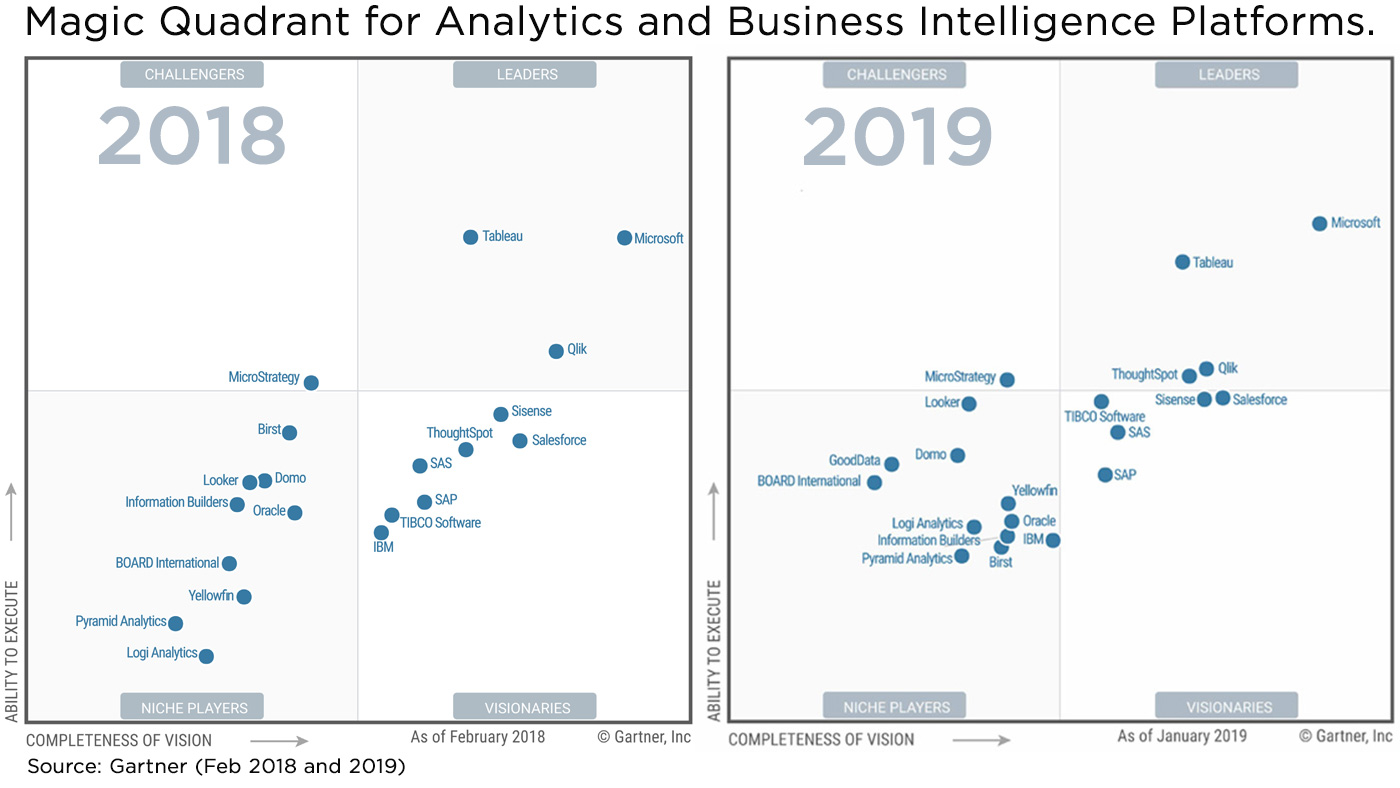
Its advanced data preparation is a differentiator as well.

TIBCO offers tools for data science, visual data discovery, and streaming analytics. Sisense is also excellent for embedded BI. Sisense is unique due to its developer framework, multipersona tools, and composable vision. Three established and top-rated vendors Sisense, TIBCO, and Yellowfin are Visionaries this year.

Beyond ThoughtSpot, several “mega-vendors” are also Visionaries again for 2022: Oracle, SAP, SAS, and IBM. ThoughtSpot is a major player in the augmented analytics market. The company has additional plans for a notebook-style SQL workspace and digital workplace tools integration. ThoughtSpot remains a stone’s throw away from attaining Leaders status but introduced several key feature updates (Everywhere, developer playground, custom action, pre-builds for KPIs). Domo has lots of momentum in the space, according to Gartner. The company is also popular in multi-cloud scenarios where an organization chooses non-Microsoft clouds. Domo mostly sells directly to lines of business due to its ease of use. Google continues to integrate Looker with its other products (namely Google Data Studio) in the near term, and new extension frameworks are a fully hosted development surface that enables developers to build data-powered apps. Google (Looker) and Domo are the lone market Challengers for 2022. Qlik added a slew of new capabilities in 2021 (including technology buys) and has plans to go public soon. That combined with a business user-centric approach and an “in” to the Salesforce ecosystem has its arrow pointing straight up. Salesforce (Tableau) recently dropped new Slack integrations and an improved NLQ experience. While Microsoft touts massive market reach and a comprehensive product roadmap, its new “goals” capability, an alignment with other productivity tools, and good price-to-value ratio keep it atop the list. At Solutions Review, we read the report, available here, and pulled out the key takeaways.įor the second-straight year, Microsoft (Power BI), Tableau (now a part of Salesforce), and Qlik dominate the market. The graph is divided into four quadrants: niche players, challengers, visionaries, and leaders. In this Magic Quadrant, Gartner evaluates the strengths and weaknesses of 20 providers that it considers most significant in the marketplace and provides readers with a graph (the Magic Quadrant) plotting the vendors based on their ability to execute and completeness of vision. BOARD International, Infor (Birst), and Information Builders were removed for no longer meeting the inclusion criteria.

As a result, Incorta, Tellius, and Zoho were added to the report.
#Best data visualization tools gartner software#
Gartner adjusts its evaluation and inclusion criteria for Magic Quadrants as software markets evolve. Gartner highlights the following providers in the analytics query accelerators market: Microsoft (Power BI), Salesforce (Tableau Software), Qlk, Google (Looker), Domo, ThoughtSpot, Sisense, Oracle, TIBCO Software, SAP, IBM, SAS, Yellowfin, Tellius, Amazon Web Services (AWS), MicroStrategy, Alibaba Cloud, Pyramid Analytics, Zoho, and Incorta. This is good for the consumer, as it pushes many of the providers to improve their analytics features while helping organizations maintain a balance between control and agility while scaling multipersona, advanced analytics tools, and new and emerging use cases.

As a result, the markets for data science and machine learning software and cloud data analytics tools are diverging from that of traditional BI platforms. Many of the best business intelligence solutions are adding capabilities for users to create no-code automation workflows and applications. The researcher expects this will be a trend that continues as analytics and business intelligence tools get integrated into personal productivity tools. These platforms are also beginning to capture more information about user behavior and interests in order to deliver the most impactful experience possible. However, that augmentation is largely shifting from the analyst to consumers and decision makers. Gartner notes that the market is represented by an emphasis on visual self-service for end-users, as well as augmented AI to deliver automated insights. ABI platforms may optionally include the ability to create, modify or enrich a semantic model including business rules.” Gartner defines the marketplace as enabling less technical users, including businesspeople to “model, analyze, explore, share and manage data, and collaborate and share findings, enabled by IT and augmented by artificial intelligence (AI). has released its 2022 Magic Quadrant for Analytics and Business Intelligence Platforms. The editors at Solutions Review highlight what’s changed since the last iteration of Gartner’s Magic Quadrant for Analytics and Business Intelligence Platforms and provide an analysis of the new report.Īnalyst house Gartner, Inc.


 0 kommentar(er)
0 kommentar(er)
